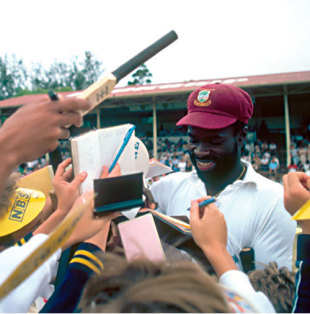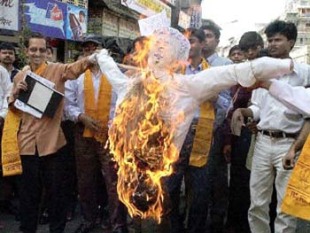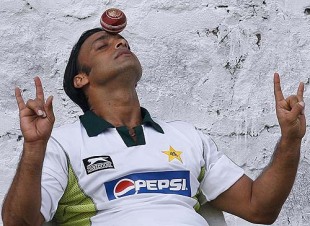Bad boys
In a week where Shane Bond's international career appears to have been prematurely ended by the Indian board, we look at XI other examples of players being banned
Martin Williamson and Andrew Miller
31-Jan-2008

| ||
Packer's rebels 1977-79
The first collective splutter from those running the game followed the signing of dozens of the world's leading players by media magnate Kerry Packer. Reaction was mixed. In Australia they banned the lot of them, even preventing Jeff Thomson from playing at all for a year while his contract with the board expired. In England they thought about it but realised it was not legally possible so dropped them after the 1977 season. The West Indies board tried to act but were forced into an embarrassing climbdown, while the Pakistan board seemed unsure whether it was coming or going. Peace was restored when the two sides settled in 1979 but some careers - most notably Tony Greig's - never recovered.
The first collective splutter from those running the game followed the signing of dozens of the world's leading players by media magnate Kerry Packer. Reaction was mixed. In Australia they banned the lot of them, even preventing Jeff Thomson from playing at all for a year while his contract with the board expired. In England they thought about it but realised it was not legally possible so dropped them after the 1977 season. The West Indies board tried to act but were forced into an embarrassing climbdown, while the Pakistan board seemed unsure whether it was coming or going. Peace was restored when the two sides settled in 1979 but some careers - most notably Tony Greig's - never recovered.
England, West Indies and Sri Lankan rebels 1982-1990
In the 1980s South Africa started luring rebel sides from overseas to appease a sports-starved public and it soon became clear that almost everyone in the game had their price. The West Indies and Sri Lankans paid a heavy price with life bans and, in the Caribbean, public vilification. England's players were handed three-year bans after their 1981-82 tour, and it proved such a deterrent that John Emburey went back for seconds in 1989-90, for which he copped another three years on the sidelines.
In the 1980s South Africa started luring rebel sides from overseas to appease a sports-starved public and it soon became clear that almost everyone in the game had their price. The West Indies and Sri Lankans paid a heavy price with life bans and, in the Caribbean, public vilification. England's players were handed three-year bans after their 1981-82 tour, and it proved such a deterrent that John Emburey went back for seconds in 1989-90, for which he copped another three years on the sidelines.
Hansie Cronje 2000
The world scoffed when Hansie Cronje was first implicated in the matchfixing scandal - no-one seemed less likely to throw a match than this God-fearing golden child of South African cricket. But then, in a midnight confessional than stunned the game, Cronje revealed all. He confessed before the King Commission that he had "an unfortunate love of money", and had accepted at least $130,000 from bookmakers, including Marlon Aronstam who presented him with a leather jacket after the infamous innings forfeiture against England at Centurion in January 2000. Under his leadership, Herschelle Gibbs and Henry Williams were coerced into underperforming in one-day internationals in India in March 2000, and were each banned for six months.
The world scoffed when Hansie Cronje was first implicated in the matchfixing scandal - no-one seemed less likely to throw a match than this God-fearing golden child of South African cricket. But then, in a midnight confessional than stunned the game, Cronje revealed all. He confessed before the King Commission that he had "an unfortunate love of money", and had accepted at least $130,000 from bookmakers, including Marlon Aronstam who presented him with a leather jacket after the infamous innings forfeiture against England at Centurion in January 2000. Under his leadership, Herschelle Gibbs and Henry Williams were coerced into underperforming in one-day internationals in India in March 2000, and were each banned for six months.
Mohammad Azharuddin 2000
The rise and fall of Mohammad Azharuddin is one of cricket's saddest morality tales. He was the humble bank clerk from Hyderabad who entranced a nation with the suppleness of his strokeplay, rose to become his country's captain, then plummeted in disgrace when details of his dalliances with bookmakers were made public in 2000. He was banned for life following the publication of the CBI report into the match-fixing scandal, in which he admitted to "doing" three matches between 1996 and 1999. He finished his career with 99 Tests and a highest score of 199 - apt statistical reminders of his shortcomings.
The rise and fall of Mohammad Azharuddin is one of cricket's saddest morality tales. He was the humble bank clerk from Hyderabad who entranced a nation with the suppleness of his strokeplay, rose to become his country's captain, then plummeted in disgrace when details of his dalliances with bookmakers were made public in 2000. He was banned for life following the publication of the CBI report into the match-fixing scandal, in which he admitted to "doing" three matches between 1996 and 1999. He finished his career with 99 Tests and a highest score of 199 - apt statistical reminders of his shortcomings.
Shane Warne 2003
With Man-of-the-Match performances in the semi-final and final, Warne was Australia's star of the 1999 World Cup. Four years later he stole the show again - but this time it was for vastly different reasons. On the eve of their opening fixture against Pakistan at Johannesburg, a statement from the ACB announced that Warne had failed a routine drugs test, and would be heading home to Melbourne immediately. Traces of a banned diuretic - a substance that promotes weight loss but can also be used as a masking agent for steroids - were found in his system, whereupon Warne produced one of the great excuses in sporting history. He claimed his mother had given him the pill so that he could lose his puppy fat and look good in front of the cameras. That cut no ice, however, with Dick Pound, the head of the World Anti-Doping Agency. "The source is not relevant," he said. "You cannot have an IQ over room temperature and be unaware of this as an international athlete."
With Man-of-the-Match performances in the semi-final and final, Warne was Australia's star of the 1999 World Cup. Four years later he stole the show again - but this time it was for vastly different reasons. On the eve of their opening fixture against Pakistan at Johannesburg, a statement from the ACB announced that Warne had failed a routine drugs test, and would be heading home to Melbourne immediately. Traces of a banned diuretic - a substance that promotes weight loss but can also be used as a masking agent for steroids - were found in his system, whereupon Warne produced one of the great excuses in sporting history. He claimed his mother had given him the pill so that he could lose his puppy fat and look good in front of the cameras. That cut no ice, however, with Dick Pound, the head of the World Anti-Doping Agency. "The source is not relevant," he said. "You cannot have an IQ over room temperature and be unaware of this as an international athlete."

| ||
Mark Vermeulen 2006
The former Zimbabwe batsman, who already had a reputation for eccentric behaviour, was hit with a one-year ban after a much-publicised brawl which followed him chucking a metal boundary marker at a spectator in a Lancashire league match. Within months he had confirmed all was not well by burning down Zimbabwe's cricket academy and twice banging on the gates of Robert Mugabe's presidential palace demanding to speak to the great man.
The former Zimbabwe batsman, who already had a reputation for eccentric behaviour, was hit with a one-year ban after a much-publicised brawl which followed him chucking a metal boundary marker at a spectator in a Lancashire league match. Within months he had confirmed all was not well by burning down Zimbabwe's cricket academy and twice banging on the gates of Robert Mugabe's presidential palace demanding to speak to the great man.
Shoaib Akhtar 2006-07
Pick a ban, any ban. How about the two-year suspension Shoaib received from the PCB in November 2006, following the discovery of nandrolone in his system? Or maybe you'd prefer the 13-match ban he received 11 months later (incongruously), after he attacked his fellow opening bowler - and fellow nandrolone-bannee - Mohammad Asif with a bat? That the two cricketers were still available to play was entirely due to the technicalities of the test they had undergone. It had been carried out internally by the PCB, who were not signatories of the WADA agreement at the time. Consequently, the bans were overturned on a technicality, although both men were conveniently injured come the start of the next ICC-run event, the World Cup in the Caribbean in March 2007.
Pick a ban, any ban. How about the two-year suspension Shoaib received from the PCB in November 2006, following the discovery of nandrolone in his system? Or maybe you'd prefer the 13-match ban he received 11 months later (incongruously), after he attacked his fellow opening bowler - and fellow nandrolone-bannee - Mohammad Asif with a bat? That the two cricketers were still available to play was entirely due to the technicalities of the test they had undergone. It had been carried out internally by the PCB, who were not signatories of the WADA agreement at the time. Consequently, the bans were overturned on a technicality, although both men were conveniently injured come the start of the next ICC-run event, the World Cup in the Caribbean in March 2007.
Maurice Odumbe 2004
Not your standard match-fixing saga ... this one was a tabloid editor's dream featuring an angry wife, spurned lovers, and a mysterious bookmaker. It was Odumbe's estranged wife who provided the most damning evidence which led to his being banned for five years - Odumbe himself refused to testify - but various girlfriends also added to the case against him. In his summing up, Justice Ahmed Ebrahim described Odumbe as "dishonest and devious, callous and greedy" and accused him of living a lifestyle "of pleasure and irresponsibility".
Not your standard match-fixing saga ... this one was a tabloid editor's dream featuring an angry wife, spurned lovers, and a mysterious bookmaker. It was Odumbe's estranged wife who provided the most damning evidence which led to his being banned for five years - Odumbe himself refused to testify - but various girlfriends also added to the case against him. In his summing up, Justice Ahmed Ebrahim described Odumbe as "dishonest and devious, callous and greedy" and accused him of living a lifestyle "of pleasure and irresponsibility".
Shaun Udal 2003
International recognition came late for offspinner Udal whose four England Test caps came in India and Pakistan in 2005-06 by which time he was almost 37. But while he was free to represent his county and country, he was not permitted to play for his club, Camberley, after being slapped with a three-year ban by the Surrey Championship following an altercation in a league match in 2003. It was not his first offence. In 1996 he was barred for the rest of the season after another incident while playing for Camberley.
International recognition came late for offspinner Udal whose four England Test caps came in India and Pakistan in 2005-06 by which time he was almost 37. But while he was free to represent his county and country, he was not permitted to play for his club, Camberley, after being slapped with a three-year ban by the Surrey Championship following an altercation in a league match in 2003. It was not his first offence. In 1996 he was barred for the rest of the season after another incident while playing for Camberley.

| ||
Twenty-eight villages 2007
The disappointment in India following the team's early exit from the World Cup was only to expected, but some went even further than the traditional effigy burning. A panchayat of 28 villages in Haryana banned the game entirely. "This game is making the young boys go astray," said a local leader. "They are into betting and gambling. This also leads to fights. It's better that the youngsters stay away from this game and don't even watch it." He added: "It's no different from alcoholism or the DJs who dish out noisy and senseless Bollywood songs and western music. Nobody will be permitted to either play cricket or even watch matches on TV. Any villager who opposes the ban will be ostracised." It is not certain how the panchayat reacted to India winning the ICC World Twenty20.
The disappointment in India following the team's early exit from the World Cup was only to expected, but some went even further than the traditional effigy burning. A panchayat of 28 villages in Haryana banned the game entirely. "This game is making the young boys go astray," said a local leader. "They are into betting and gambling. This also leads to fights. It's better that the youngsters stay away from this game and don't even watch it." He added: "It's no different from alcoholism or the DJs who dish out noisy and senseless Bollywood songs and western music. Nobody will be permitted to either play cricket or even watch matches on TV. Any villager who opposes the ban will be ostracised." It is not certain how the panchayat reacted to India winning the ICC World Twenty20.
Dennis Hibbert 1938-2008
In 1938 a fiery 14-year-old bowler, Dennis Hibbert, called a team-mate a "big fat fool" after he let a ball through his legs during a club match in Nottingham. It was hardly the sort of comment to turn Andrew Symonds puce with anger, but the remarks were still deemed rude enough for the uppity young Hibbert to be slapped with a ban that was not officially lifted for 70 years. In January 2008, Hibbert attended a funeral tea in the Kimberley Institute pavilion, where he was reminded he was still, officially, persona non grata. "It must be the longest on record," said the club secretary Jim Dymond, while Hibbert - now a grandfather of five - said: "There are very few people who have been banned for 70 years from anything. But now I've been purged from my sins and admitted back. My family thinks it's a hoot."
In 1938 a fiery 14-year-old bowler, Dennis Hibbert, called a team-mate a "big fat fool" after he let a ball through his legs during a club match in Nottingham. It was hardly the sort of comment to turn Andrew Symonds puce with anger, but the remarks were still deemed rude enough for the uppity young Hibbert to be slapped with a ban that was not officially lifted for 70 years. In January 2008, Hibbert attended a funeral tea in the Kimberley Institute pavilion, where he was reminded he was still, officially, persona non grata. "It must be the longest on record," said the club secretary Jim Dymond, while Hibbert - now a grandfather of five - said: "There are very few people who have been banned for 70 years from anything. But now I've been purged from my sins and admitted back. My family thinks it's a hoot."
Martin Williamson is executive editor and Andrew Miller is the UK editor of Cricinfo